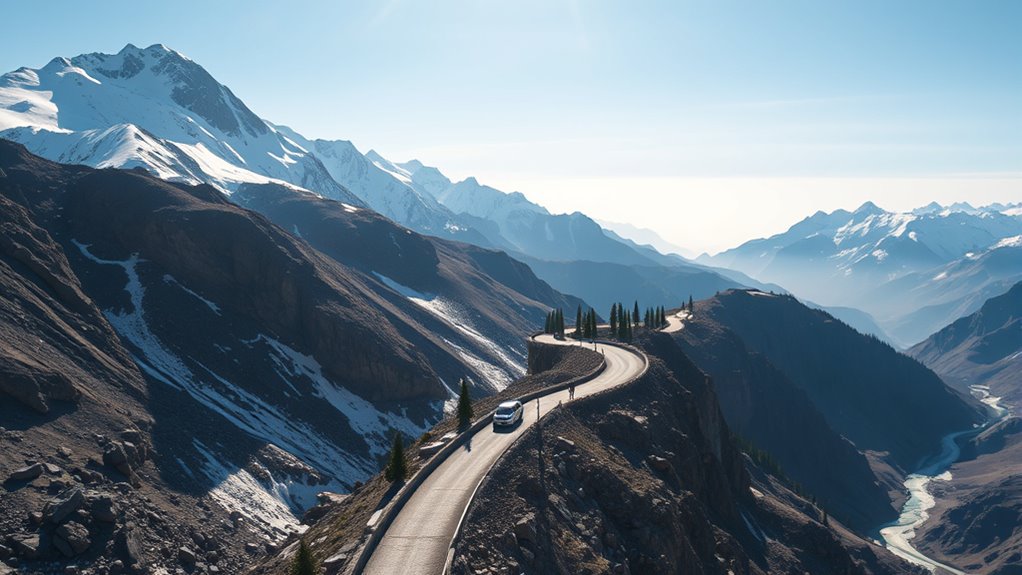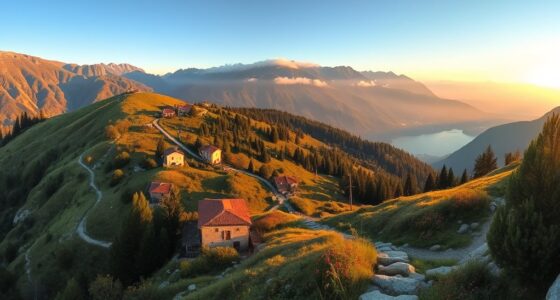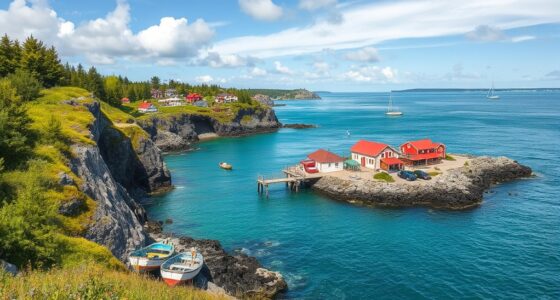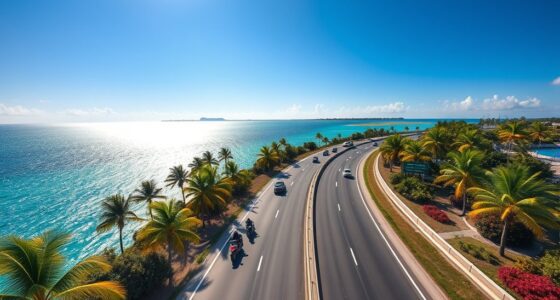To survive the Manali-Leh Highway, guarantee your vehicle is well-maintained, with full fuel and replacement parts. Pack essential supplies like water, warm clothing, and a first aid kit. Stay alert to changing weather and road conditions, driving cautiously on narrow, uneven paths. Monitor symptoms of altitude sickness and ascend gradually. Carry emergency contacts and communicate your plans. If you keep these tips in mind, you’ll be better prepared for the challenges ahead.
Key Takeaways
- Prepare your vehicle thoroughly, checking brakes, tires, fluids, and fuel, and carry extra fuel for remote stretches.
- Pack essential supplies like warm clothing, water, snacks, first aid kit, and emergency shelter for high-altitude conditions.
- Monitor weather forecasts closely; be prepared for rapid changes, snowstorms, fog, and road closures.
- Acclimatize gradually to prevent altitude sickness, stay hydrated, and recognize symptoms early for prompt action.
- Maintain safety by sharing travel plans, carrying a charged phone, respecting local customs, and avoiding risky shortcuts.
Preparing Your Vehicle for the High Altitude Journey
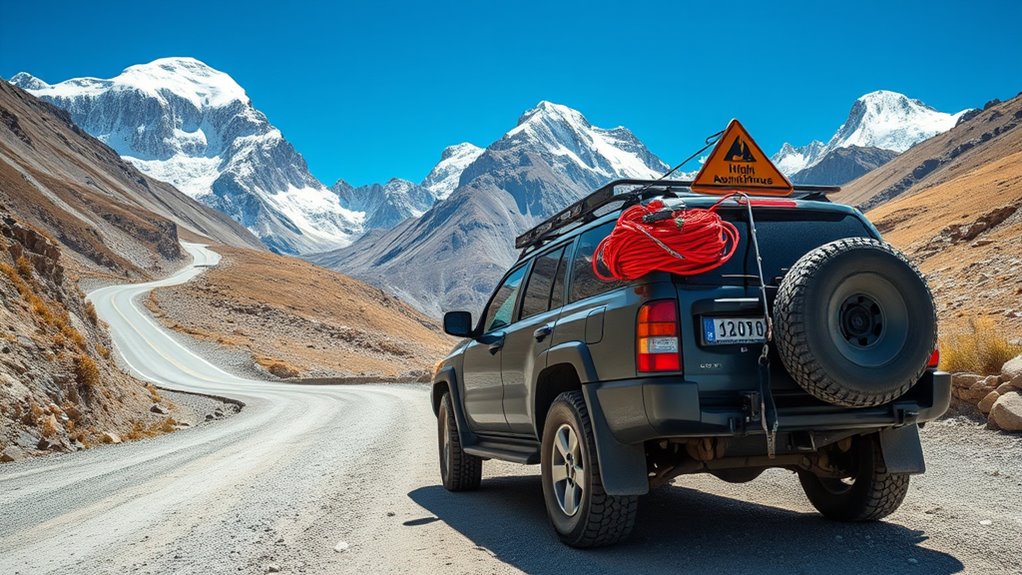
Before setting out on the Himalayan Manali-Leh highway, it’s crucial to make certain your vehicle is well-prepared for the challenging high-altitude conditions. Start with thorough vehicle maintenance—check the brakes, tires, fluids, and engine health to prevent breakdowns. High-altitude driving can strain your vehicle, so ensure it’s in top shape. Fuel planning is equally important; fuel stations are sparse, so fill up fully before starting and carry extra fuel if possible. Keep an eye on the fuel gauge and avoid running low. Proper vehicle maintenance minimizes the risk of mechanical issues, while strategic fuel planning ensures you won’t get stranded in remote stretches. Being prepared with a reliable vehicle and enough fuel will help you navigate the rugged terrain safely. Regularly inspecting your vehicle’s engine health can help prevent unexpected breakdowns in remote areas, especially since high-altitude conditions can affect vehicle performance.
Essential Gear and Supplies to Carry Along
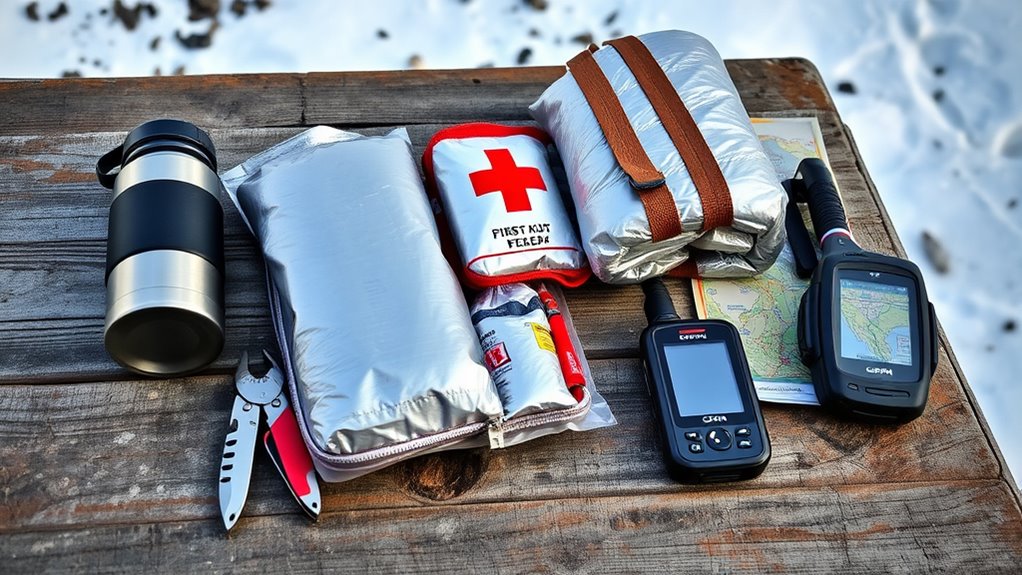
Carrying the right gear and supplies is essential for a safe and smooth journey along the Himalayan Manali-Leh highway. Make certain you have basic first aid kits, warm clothing, and sufficient water. Don’t forget a good camera or smartphone to capture stunning views of cultural landmarks and local cuisine along the route. Pack snacks that provide energy during long stretches between towns. A power bank is handy for keeping devices charged, especially when exploring remote areas. Remember, the region’s high altitude can affect your health, so carry medications if needed. To truly enjoy your trip, bring a map or GPS device to navigate local routes confidently. Being prepared guarantees you won’t miss out on scenic sights or authentic culinary experiences. Additionally, remote work capabilities can be useful if you need to stay connected for work or emergencies during your journey. Ensuring your vehicle is equipped with air quality awareness tools can help monitor and manage the changing air conditions in the region. Incorporating Vetted – 1st Home Theatre Projector options for entertainment can also enhance your experience during downtime or in case of unexpected delays. Furthermore, packing a compact emergency shelter can provide peace of mind in case of unforeseen weather or vehicle issues. It’s also advisable to carry off-road recovery gear to handle potential vehicle challenges on rugged terrains.
Navigating Weather Challenges and Road Conditions
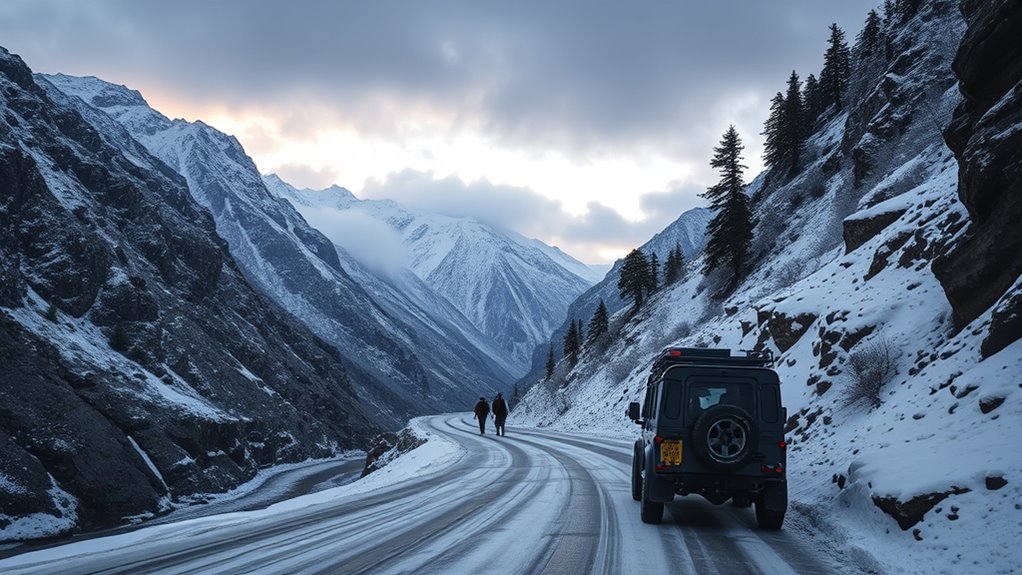
Managing weather challenges and road conditions along the Himalayan Manali-Leh highway requires attentiveness and flexibility, as these factors can change rapidly. Sudden snowstorms, heavy rainfall, or fog can make driving treacherous, so stay alert and adjust your plans accordingly. Be aware of mountain wildlife crossings; animals like snow leopards or ibex may appear unexpectedly, especially at dawn or dusk. Respect local customs by engaging with residents for real-time updates on road conditions, as locals often know which routes are safest. Keep an eye on weather forecasts and be prepared for closures or delays. Slow down on narrow, uneven roads, and always prioritize safety over speed. Using reliable Gold IRA Rollovers information can help you make informed investment decisions in uncertain times, providing greater financial security during your travels. Staying informed about security measures can also help you better understand potential risks and how to mitigate them. Being aware of emergency protocols can further enhance your safety if unforeseen situations arise. Additionally, understanding weather patterns can help you anticipate and prepare for sudden changes, ensuring a safer journey through this challenging, yet breathtaking landscape. Being familiar with local wildlife behaviors can also help you stay vigilant in animal crossing zones.
Recognizing and Managing Altitude Sickness
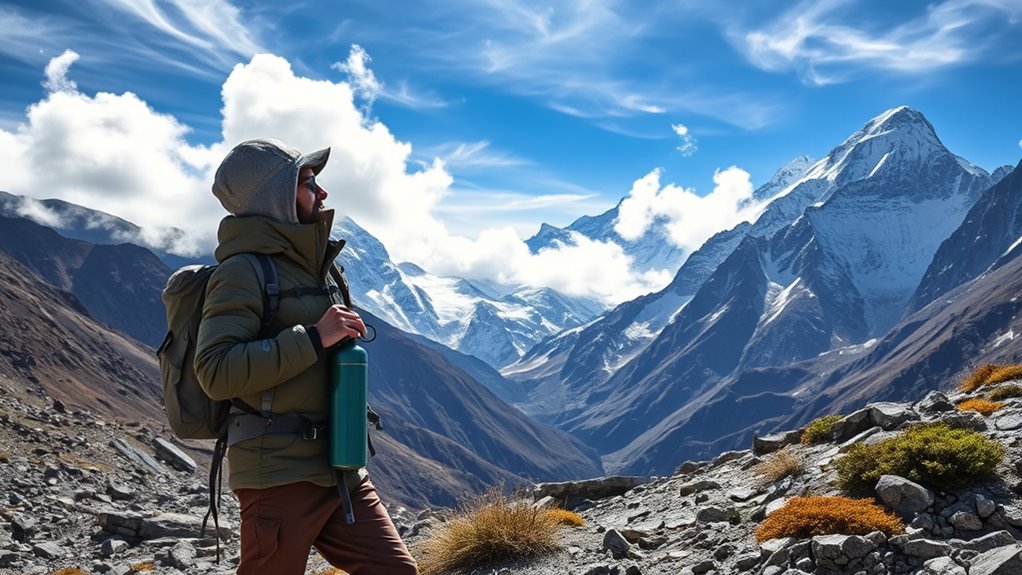
As you navigate the challenging road conditions along the Manali-Leh highway, it’s important to stay alert to how your body responds to the increasing altitude. Recognizing altitude sickness symptoms early can prevent serious health issues. Common signs include headache, dizziness, nausea, and shortness of breath. To manage this, use acclimatization techniques such as gradual ascent, staying hydrated, and taking rest days. Pay close attention to your body’s signals and don’t ignore mild symptoms. If symptoms worsen, descend to a lower elevation immediately. Remember, proper acclimatization is key to safe travel in high-altitude regions. Staying vigilant helps you avoid severe altitude sickness and ensures a safer journey through the Himalayas. Digital literacy can also be a helpful tool in preparing for such trips, providing access to useful information and safety tips. Additionally, being aware of altitude sickness prevention strategies can further enhance your safety. Proper planning and knowledge about the Himalayan terrain can make a significant difference in your overall safety. Being familiar with high-altitude health risks allows travelers to be better prepared for the physical challenges they may face, and understanding altitude acclimatization processes can greatly reduce the risk of altitude sickness.
Safety Tips for Remote and Isolated Sections
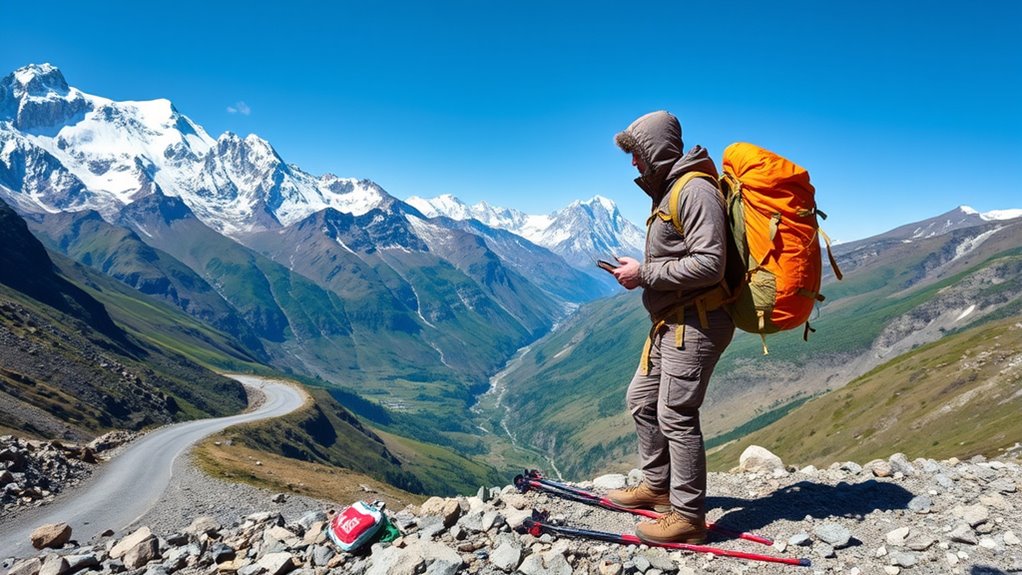
When traveling through remote and isolated sections of the Manali-Leh highway, your safety depends on careful preparation and awareness. Know the local customs to respect traditions and avoid misunderstandings, which can be vital in unfamiliar areas. Carry a fully charged phone and note down emergency contacts, including local rescue services and your embassy if possible. Share your travel plan with someone reliable, and check weather forecasts regularly. Keep essential supplies like water, snacks, and a basic first aid kit handy. Be cautious when interacting with locals and avoid risky shortcuts. In case of an emergency, staying calm and contacting the right authorities can make all the difference. Automation technologies can also assist travelers by providing real-time updates and navigation assistance. Preparedness and awareness are your best tools for a safe journey through these remote sections.
Frequently Asked Questions
What Are the Best Times of Year to Travel the Highway?
The best seasons to travel the highway are during spring (April to June) and early autumn (September to October). During these times, the weather is generally clear and pleasant, making your journey smoother. Avoid winter months (November to February) when heavy snowfall can block the route, and summer (July and August) might bring monsoon rains, causing landslides. Always check weather considerations before planning your trip to guarantee safety.
Are There Available Emergency Services Along the Route?
When traveling this route, you’re never far from a helping hand, but it’s wise to stay prepared. Roadside emergencies can happen unexpectedly, so guarantee you have access to communication facilities like mobile signals or satellite phones. While some emergency services are available along the highway, coverage isn’t guaranteed everywhere. Always carry essential supplies, and don’t rely solely on nearby services—they might be a call away or need time to arrive.
How Can I Find Local Medical Assistance if Needed?
If you need local medical assistance, you should first look for nearby medical facilities or clinics along your route. Keep emergency contacts handy, including local hospitals and rescue services, to get quick help if needed. It’s also wise to ask locals or your accommodation staff for directions and recommendations. Being prepared with these contacts guarantees you can access prompt medical aid during your journey, enhancing your safety.
What Cultural Tips Should Travelers Keep in Mind?
Cultural cues create connections, so respect local customs and dress code. You should observe traditional attire, especially in sacred sites, and avoid inappropriate clothing that might offend. Be polite, patient, and practice proper greetings to foster friendliness. Remember, modesty matters; it shows respect and helps you blend in. By embracing these cultural tips, you’ll build bridges, boost understanding, and enjoy a richer, more respectful journey through the region’s vibrant villages and valleys.
Are There Recommended Local Guides or Tour Operators?
You should explore local guide options and tour operator recommendations before your trip. These guides can enhance your experience by sharing local insights and ensuring safety on challenging routes. Look for reputable tour operators with good reviews, as they often offer well-trained guides familiar with the terrain. By choosing trusted local guides, you’ll enjoy a safer, more enriching journey through the scenic landscapes and cultural sites along the highway.
Conclusion
Starting on the Manali-Leh highway demands preparation and vigilance, but with the right mindset, you can conquer this epic adventure. Keep your vehicle in top shape, pack essential gear, and stay alert to weather shifts and altitude symptoms. Remember, this journey is more than a drive—it’s a test of resilience and spirit. Stay safe, stay smart, and you’ll emerge from this high-altitude odyssey with stories as legendary as the mountains themselves.
